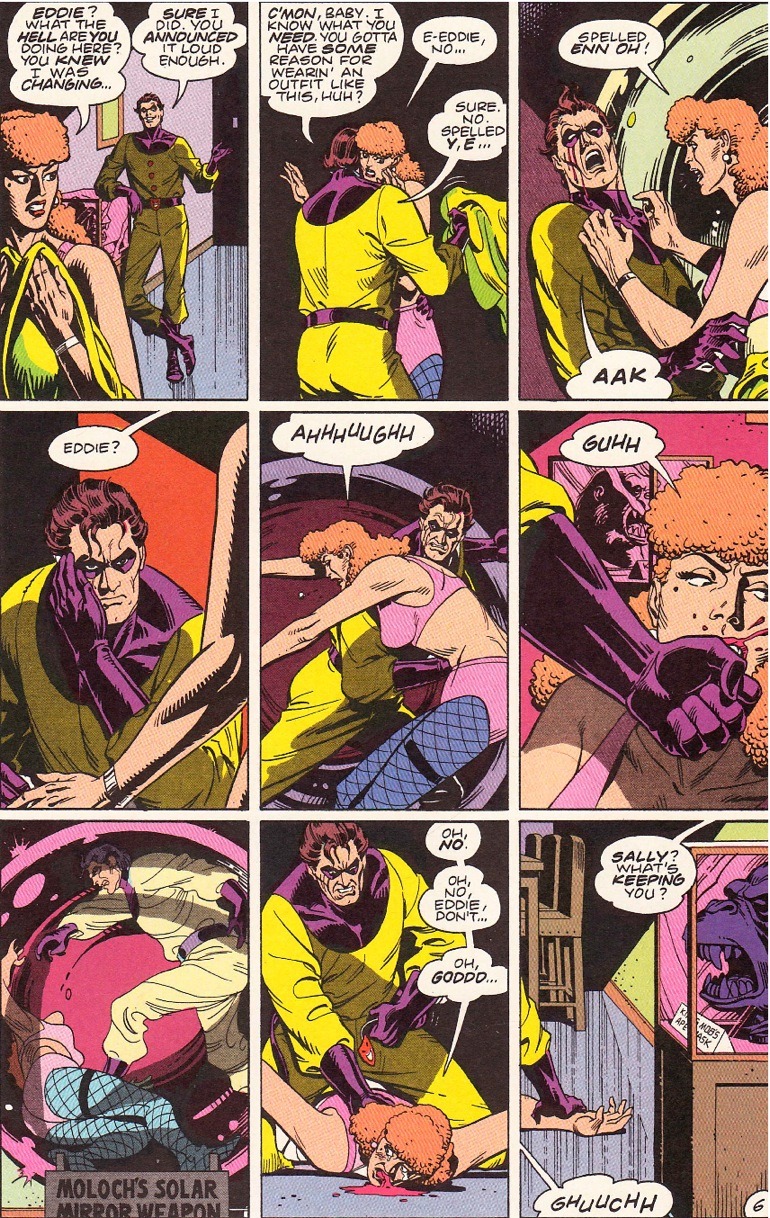
This article reprints a 2014 article from my old site, without change
This is an article on comic book rapes.
That’s right.
Zombie incest rape. Man-on-man rape. In comic books.
It’s happened more often than you think…Hit more if you want to read this column, but I’m warning you: It’s pretty dark. I’m not sure why I was inspired to write it.
Rape is actually a surprisingly common comic book trope. Huntress, Sin, Green Arrow, Dick Grayson, Carol Danvers, and many others have had a “rape” story…But they usually don’t matter, in that they don’t change the character in any lasting way. There are a few basic “types” of comic book rapes.
Most of the time, it’s implied…Like when Speedball did time in prison during Civil War…
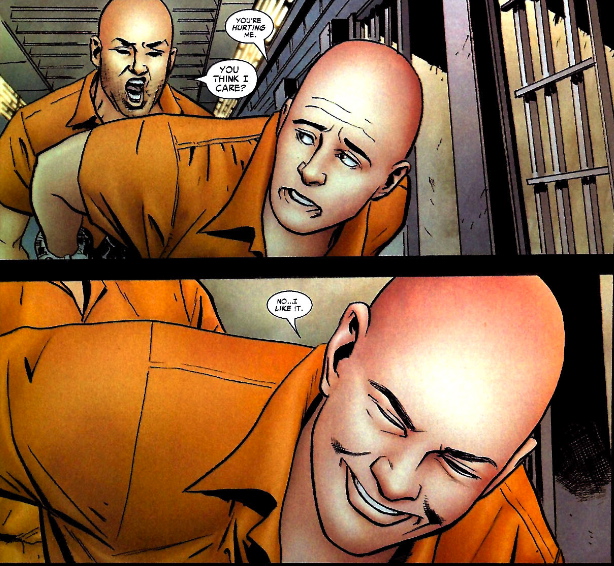
This is a rape…
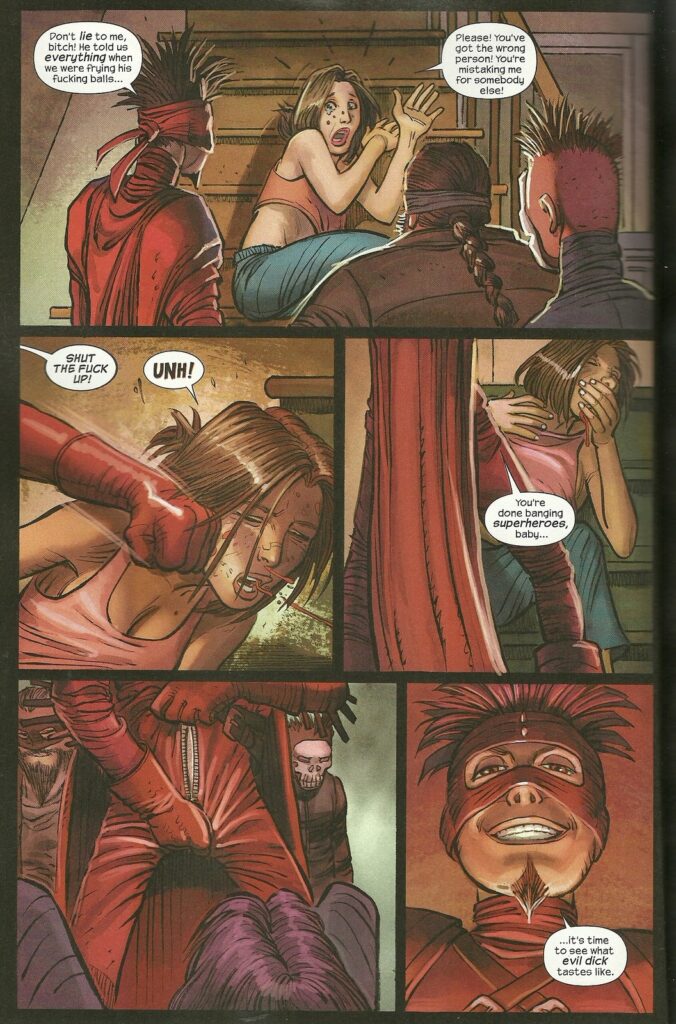
Mark Millar was quoted by The New Republic as saying that his use of gang rape in Kick-Ass 2 was just to show how bad the guy was, saying that rape doesn’t matter in comics. Every single article I’ve read about it demonizes him as insensitive, stupid, and somehow contributing to what seems to be described as either a “pro-rape” or at least a “condoning by not discussing rape” Western culture.
Come on, guys. Millar may be mysogynist, but he’s hardly pro-rape.
What he meant was, it’s not any bigger a deal than a decapitation (which he also discussed). Now, Millar is a guy who uses rape quite a bit, and he catches more flak for it than Garth Ennis.

Laura Hudson (senior editor at Wired) responded, in the same article, by saying rape and decapitation aren’t the same:
“It’s using a trauma you don’t understand in a way whose implications you can’t understand, and then talking about it as though you’re doing the same thing as having someone’s head explode. You’re not. Those two things are not equivalent, and if you don’t understand, you shouldn’t be writing rape scenes.”
I’m not sure I agree with her: Millar no more understands what it is like to be raped than he understands what it is like to have his head explode. Moreover, the experience of being raped (or having your head exploded) is hardly singular or universal; different people respond in different ways to the same situation, and ultraviolence is ultraviolence. I know this because I am disabled, and I can’t tell you how many times I’ve had people say to me: “If I had to live with what you go through, I’d never be able to handle it!” Bullshit. You can’t possibly know what it’s like, and know if you would actually kill yourself.
But those people aren’t stupid, they’re just ignorant. And if they’re writing a work of fiction about what it’s like to suffer, they might draw on their own experience as an example—just like they do in real life.
In other words, Millar’s use of rape to measure depth-of-evil says much more about him and his own fears than it does about rape itself. Just as everything a writer does says more about the author than the reader. When different readers can walk away with different interpretations of the same work of fiction, it says more about the reader than the author. And when a reader speaks about an author, they need to keep that in mind.
Of course our culture is more afraid of discussing rape than exploding heads, and people who haven’t been raped do lack the same context as people who have.

They cut Micchone’s rape scene out of The Walking Dead’s TV show, and they’re cutting the one above out of the Kick Ass 2 movie, because the topic is deemed too disturbing. And yet heads explode constantly in Walking Dead, and Kick Ass 2 will feature brutal torture. They certainly never included all the bondage and implied rape from dozens of 1950s Wonder Woman comics.
Why are we afraid to depict rape? And if writers choose to depict it, rather than calling them insensitive or inartful, maybe we should be happy that the issue is being discussed at all? Or is this like when rap culture adopted the “N” word, and then were criticized for making a hateful word less hateful by coopting it and taking the punch out of it.
So, how DO comics depict sexual violence?
1. Sexual Violence as Mood Music
Many books—particularly modern ones—use sexual violence and rape to set a tone for a book or a story arc. This is what Mark Millar was talking about.
The Walking Dead’s “Governor” storyline used sexual violence as a theme to establish a character’s brutality. It actually ended up being handled rather poorly, as Micchione’s retaliation seemed to alleviate the effects of the incident, so that her character didn’t really change much (or at all) afterwards. Then there’s a book like Crossed, which used animalistic, ultraviolent sex as the core of it’s story: Those who have been taken by the Crossed are consumed by the desire to combine sex and painful death, and the book itself became a story about the meaning of God in a brutal world. (At least it did under Garth Ennis—the subsequent volumes are little more than torture porn.)
2. Rape Origins.
The “backstory” rape is the most common: A tale of violence used as a foundation for a character; unfortunately, they usually don’t do anything with it later on.

Use of rape in an origin story is best exemplified by The Black Cat. In Kevin Smith’s miniseries “Spider-Man/Black Cat: The Evil That Men Do,” a drug lord captures Black Cat and rapes her. In the story, Matt Murdock tries to get her to submit to an evidentiary rape kit in order to defend charges filed against her for the murder of that same drug lord, but she denies being raped. However, we do learn that she was raped in college, which is what motivated her to become a martial artist: Revenge.
The problem with the Black Cat example, is that she’s best known as a flirty sexpot who is comfortable with her own body and sexuality, and doesn’t seem to have any noticeable emotional scars from her ordeal. In fact, other than in Kevin Smith’s miniseries, you never hear about it again.
Same thing with Rogue, who was raped while in prison during the Genosha storyline. It all happened off-panel, and you never hear about it again and, frankly, her character already had all kinds of sexual confusion so it didn’t really add anything. Other than that it was how she lost her virginity.
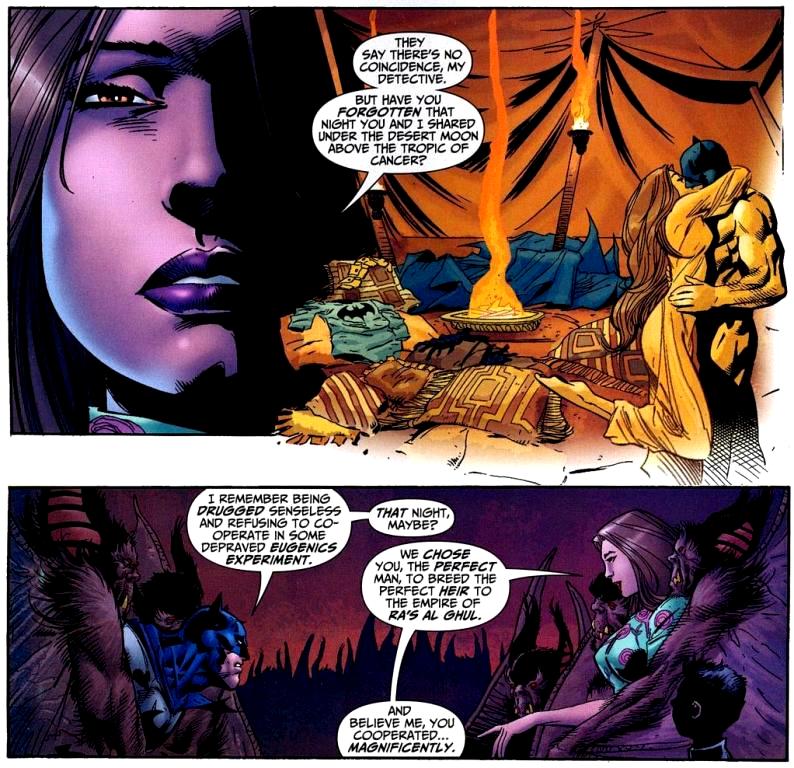
Another odd origin rape is Damian Wayne. No, he wasn’t raped himself, but Talia Al Ghul got pregnant after slipping Batman downers and Viagra. He didn’t even remember having had sex with her at first. This is more of Grant Morrison’s own sexual fetish, I think, than an example of involuntary sexual contact in comics.
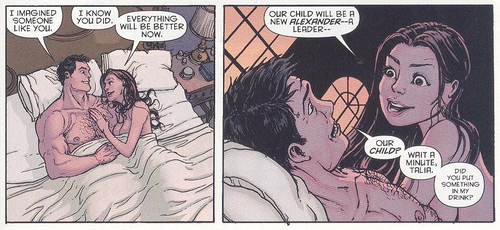
In fact, aren’t these rapes almost worse than the “casual” or “mood-setting” rapes that everyone is yelling at Mark Millar about? I mean, the subtext here is that good things–heroic things–can come from rape. And while I know several close female friends of mine who were raped and, in my opinion, went on to become great women–that message, at its core, is more offensive than “I want to establish that a dude is evil so I’m gonna have him rape someone.” Because it’s not being raped that made these women great, it’s how they grew and developed after experiencing traumatic experiences.
3. Rapes that “matter”
These are a little like “origin story” rapes, but they’re more of “turning points” than starting points. Check out The Maxx (Image Comics), created by Sam Keith, in which several characters have violent sexual traumas that actually matter. One of the characters, Mr. Gone, is a serial rapist, and his impact on one of the central characters of the book, Julie, forms the basis for an ongoing character arc—including a story involving the serial rapist’s daughter coming to Julie for counseling. This is actually a rare example of a mature treatment of the issue.
Then there’s Garth Ennis and Darick Roberson’s “The Boys,” in which superheroes regularly abuse women. The rape of Starlight, a wannabe super-heroine, who is forced by the equivalent of Superman to have sex if she wants to be on the team, becomes the thing that transforms not her so much as her boyfriend. This is a pattern throughout comics: When women get raped, men get affected.
Similarly, Jaka’s rape in the pages of Cerebus the Aardvark was used to tell us more about Cerebus than Jaka, but in my mind it stands out as the most potent, impactful use of a power-based sexual relationship in the history of comic books. I’ve read the storyline at least ten times, and it still provokes all kinds of mixed reactions. Does Jaka love Cerebus because he is dominant, or in spite of it? In the beginning, it’s not clear, but by the end of her experience, she’s definitely a changed woman—yet she’s changed for the better, in many ways. Viewing all this through creator Dave Sim’s own misogyny, this book becomes even more fascinating.
The rape of Carol Danvers that led to her pregnancy in Avengers #200 was an example of a “big two” book that actually used the rape as a basis for the entire character to transform into something different. As far as I know, that was the only time a Marvel or DC character was radically affected for a long period of time by an incident of sexual violence. Other than in a MAX or Vertigo title.
Speaking of MAX titles: Jessica Jones was used as a sex slave in Alias. This one rates high for me because the treatment of the issue is mature, and it has lasting effects on the character. At the end of his amazing comic book, Alias, Brian Michael Bendis wrote a story about Jessica Jones being held prison by The Purple Man and forced to be his sexual partner. You never really see it, it’s just suggested, and you see how Jones reacts to it—what it does to her. This is the best written rape in Marvel history, because it doesn’t shy away from the emotional impact it has on the victim. It also helps explain the character’s depression and alcoholism, and why she’s so reluctant to get into relationships with several good men, like Scott Lang and Luke Cage (who she eventually does marry).
But the “effect on men” issue is raised later, in the first New Avengers story arc, in which Luke Cage has the opportunity to slam Purple Man down to the street top.
Wouldn’t the comic have been that much better if Jessica herself had done that?
4. Man-on-Man Rape
Comics are largely written, drawn, edited, colored, lettered, etc. by men. And for many (most?) men, being raped is a huge fear. And comic books really aren’t about deep psychoanalysis (at least most aren’t). So it’s not surprising that there is little serious consideration of the issue of man-on-man rape, other than in a purely homophobic context.
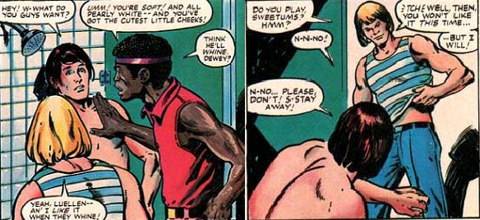
Like when Bruce Banner showered with men at the YMCA.
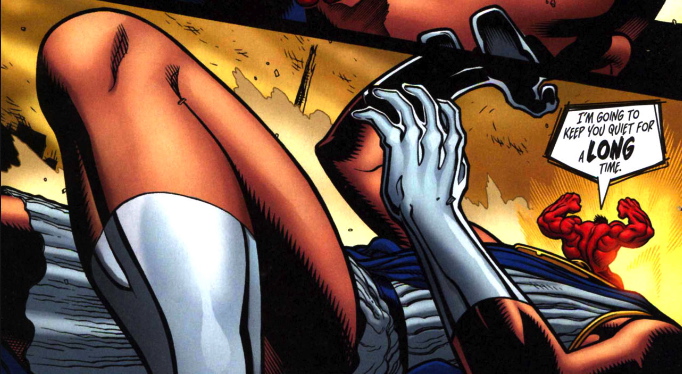
Or when Red Hulk face-raped The Watcher.
The best use of male rape is in Jason Aaron and Steve Dillon’s take on the early years of Punisher in Marvel’s Punisher MAX. We see the origin of the Kingpin: Turns out, Wilson Fisk was raped in a prison shower by multiple assailants.
That might make me mean, too.
5. Alan Moore Rapes
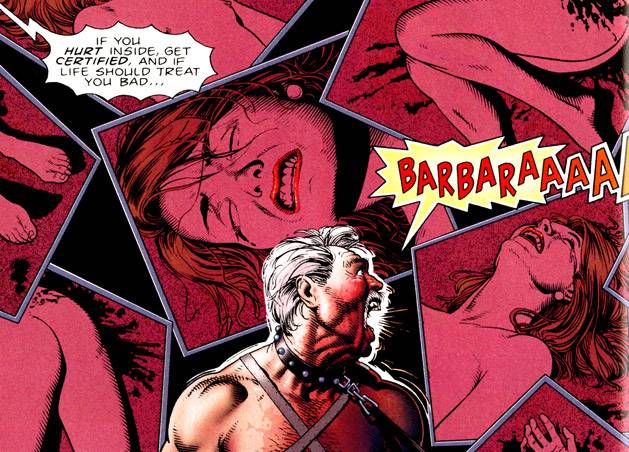
Nobody likes to write about rape more than Alan Moore. Sexual violence/fetishization of deviant or aggressive sexuality is a central theme in many of his most celebrated books (From Hell, Watchmen, Lost Girls) and his most vilified (Neonomicon). You could probably write a thesis on his portrayals of sexuality. Hell, I bet someone already has.
The Killing Joke, Alan Moore’s brilliant and dark Joker story, is probably his best rape story. It’s the one where Barbara Gordon is shot and paralyzed, which turns her from a cocky swashbuckler to a cyber detective confined to a wheelchair. It’s not clear whether she is actually raped—it’s implied. But the most disturbing part of the book is the end, in which the Dark Knight who rescued her confronts the evil assassin and…Has a good laugh. Batman and Joker laugh together at the end of the comic. It’s the only part of this famous Graphic Novel that has always bothered me.
Actually, most of Alan Moore’s portrayals of rape are deeply flawed, disturbing, and, frankly, superficial.
Take Neonomicon’s demon rape. Alan Moore and Jacen “Crossed” Burrows teamed up for a violent, disturbing Avatar Press comic that actually centered almost entirely around rapes. Gang rapes, ritual rapes, and demon-raping-woman rape. I actually thought this was a very powerful comic, but it is far from appropriate if you’re weak of heart. It takes a tough stomach to get through it. But, like Burrows’ work on Crossed, the rape is clearly exciting to the artist. This is a horrible thing, but it is told in an erotic (albeit violent) manner. I’m not criticizing this portrayal, but it’s a far cry from a mature examination of how most rapes occur.
In fact, I don’t think it’s fair to criticize any of Moore’s uses of sexual assault: He’s got his reasons, and most are artistic expression. I don’t necessarily relate to them, or find them “real” or resonating, but I understand them in the context of the story he’s telling.
And let’s close this out with the most brutal rape/homicide in the history of comic books. And, it’s actually a two-fer.
In volume one of his over-rated “historical superhero” series, The League of Extraordinary Gentleman, the Invisible Man is portrayed as a serial rapist of underage girls at a correctional school. It’s a very bizarre (and unpleasant) storyline, with the fact that he’s invisible leading to a conclusion that the women he impregnates are experiencing virgin births.
But Invisible Man gets his comeuppance in Moore’s version of street justice when, in LOEG volume 3, Mr. Hyde anally rapes the Invisible Man until he is dead. It’s horrifying, actually, because you never see Invisible Man. You just see his blood, and more and more of it, until the rape is over.
Okay. I feel filthy. This article is over.
Drop me a comment and tell me what you thought of it.


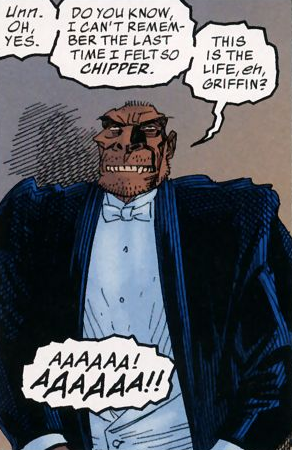
I’ll tell you what I thought of it. I’ll tell you EXACTLY what I thought of it. I am going to take the “old school” approach to this topic, because it needs to be taken here. Rape/sexual assault has no place in comic books for the simple reason that the primary reason for the existence of comic books in ENTERTAINMENT. PERIOD. There is ABSOLUTELY NOTHING EVEN REMOTELY “ENTERTAINING” about RAPE and/ or SEXUAL ASSAULT, and if you DISAGREE with this, then you are DISTURBED, and you need HELP. These so-called “artists” who revel in giving us comic books that focus on rapists and sexual assault do not deserve their platforms as comic book professionals. Seventy years ago, an institution called The Comics Code Authority was initiated for the PRECISE REASON for keeping this type of garbage OUT of comic books, PERIOD. By the mid-1950’s, the United States Government was on the verge of SHUTTING the comic-book industry DOWN over this issue, as well as the over-preponderance of gore and violence. The comics companies of the time- National Periodical Publications, ( who were relatively blameless ) Atlas, ( precursor to Marvel ) and EC ( the main culprit ) had to promise Uncle Sam that they would “play nice” and stop generating lurid, unwholesome garbage that wasn’t fit for publication in order to remain in business. The result was the Comics Code Authority, the comic books industry’s self-imposed guideline for preventing the comics industry from driving themselves into extinction. It worked for about fifty years, until the comics industry became so emboldened by their own success that it decided that it no longer needed to regulate it’s content. The RESULT has been the garbage posted above. The world doesn’t need Mark Millar if he thinks comic books needs to feature stories about rape and misogyny. Mr. Ekko posts above that “Just because Millar is a misogynist doesn’t mean he’s pro-rape.” Oh, REALLY-???? Sir- rape/sexual assault is a natural extension and outgrowth of misogyny. They are two sides of the same coin. Consult a psychologist if you disagree. Alan Moore, similarly, should be held accountable for giving us the events of ‘The Killing Joke’, and in later years, Moore himself admitted this, citing in interview, “Yeah, I wish DC had kinda ‘reined me in’ on that one.” Yeah, I kinda wish DC had, as well. Nevertheless, thirty-six years later, DC has more-or-less ‘retconned’ the events of “The Killing Joke” out of DC continuity, and I think that’s a good thing. Barbara Gordon becoming a paraplegic as a result of her perhaps ill-advised ‘Batgirl’ career was not the worst thing, and, frankly, something like that happening to a member of the non-super-powered, non-omnipotent Bat-family was probably inevitable from a standpoint of sheer mathematical odds, but, nevertheless, all the lurid, sensationalistic details surrounding it were absolutely uncalled for, and unnecessary. Barbara’s career as “Oracle” COULD have stood as a great example of DC giving the world a terrific lesson in making lemonade out of lemons, if ONLY they could have done so without the ample helpings of pornographic violence. In any event, today, Batgirl is back with us in full force and no worse for wear, in a classic example of “This is just pure fantasy bullshit, and we, as comics readers should not allow ourselves to become overly-invested in it.” Well, maybe not, but I WILL tell you ONE thing: I had the great, great honor to meet the beautiful and wonderful late Yvonne Craig several years prior to her tragic and untimely demise, and I am here to TELL you THIS: She was NOT AMUSED, or PLEASED. God rest her soul. And, Mr. Ekko, if, as you say above, the ONLY thing that disturbed you about “The Killing Joke” was the conclusion where Batman and the Joker had a big ol’ laugh about the ordeal of the Gordon family, then, friend, I am concerned for you. Alan Moore was RIGHT-DC SHOULD have censored him and his unnecessary graphic novel. I would like to point out that it is impossible to have a character with a superpower like that of Killgrave the Purple Man ( and his similarly-powered daughter Persuasion ) without sex slaves coming about as a result, but at least Marvel and Brian Michael Bendis handled the issue as tastefully as it could BE handled. On the OTHER hand, this business with the Red Hulk and the Watcher was TOTALLY UNNECESSARY, and stands in FULL TESTAMENT as to why the comics industry needs to reinstate the Comics Code Authority. Two final points: Batman and Carol Danvers. 1) I just happen to be the proud owner of a first-edition copy of DC’s very excellent 1987 graphic novel “Son of the Demon”, which gave us, among a few other things, Damien Wayne, by way of an ill-advised ( but arguably-unavoidable ) tryst between Batman and the admittedly and irresistible Talia Al Ghul. I have read my copy of “Son of the Demon” at least five times, and I cannot find ANY indication of ANY sort of chemical-or otherwise-sexual inducement on Miss Talia’s part, aside from her own personal and not-inconsiderable sexual wiles, in this classic tales’ impregnation sequence. Batman was not “raped”, or taken against his will by Miss Talia in any way, shape, or form! He WAS, however, SEDUCED, by a master seductress who is also, arguably, the most beautiful woman ON THE PLANET ( as her father Ra’s Al Ghul once attested in 1978’s “I Now Pronounce You Batman and Wife” ) All I can say about THAT sequence is that if Miss Talia, the Most Beautiful Woman on the Planet tries to take ME to bed, she’s not gonna need any chemical inducements, or booze or anyhting to make it happen, because, buddy, it’s GONNA happen!!!! Knowhutimean????? 2) Carol Danvers/Marcus. I read this, too, and I have to agree that the events of these issues ( ‘Avengers’#199-200 ) were as bizarre as they were unnecessary. Writer David Michelinie must have really hated Ms. Marvel/Carol Danvers to have done this to her, and it’s nothing short of astounding that Marvel Editorial actually ALLOWED him to do it, and to get away with it. Actually, I heard that he lost his career over it, but that’s just heresy at this point. If he did lose his career over this, he deserved it. ‘Ms. Marvel’ was created just three years prior to this unfortunate tale to stand as the exact OPPOSITE of the type of woman that Carol was reduced to in this bizarre piece of crap. At least Chris Claremont ( an ardent feminist himself ) stepped in a couple of years later and did his best to salvage this disaster, beginning in 1981’s ‘Avengers Annual’#10. It wasn’t a technical retcon, but at least he put Carol back on the road to salvation. Don’t get me wrong in this particular case- I am not a feminist, I am not huge on feminism, I am not huge on Chris Claremont, ( mainly because he hates the X-Men First Class ) I am not huge on Alan Alda or Oprah Winfrey or Phil Donahue, and, considering Carol Danver’s overall go-to-Hell attitude towards men in general, it would not overly-upset me to see a powerful super-villain come along and butter her muffin, but what was done to her in these two issues of ‘Avengers’ was done in the spirit of malice and hatred, and if David Michelinie lost his career over it, then I’m glad. Comic books are created to entertain us, and to uplift us, and superheroes and superheroines are created to uplift us and to inspire us to be the best human beings we can be, and all this garbage about them raped and sexually assaulted is counterintuitive to the entire point of their creation. Mark Millar and Alan Moore need to go, and the comic-book industry desperately needs to go back to the self-regulatory practices of the Comics Code Authority in order to save itself from the fate which damn-nearly befell it seventy years ago, before it’s too late. And THAT is how I feel about it. Nuff said!!
I’m going to disagree with the previous comment on the basis of flawed premise. Replace rape and sexual assault with other crimes and you could make the same argument against other topics in comics that get treated lightly.
“I’ll tell you what I thought of it. I’ll tell you EXACTLY what I thought of it. I am going to take the “old school” approach to this topic, because it needs to be taken here. Murder has no place in comic books for the simple reason that the primary reason for the existence of comic books in ENTERTAINMENT. PERIOD. There is ABSOLUTELY NOTHING EVEN REMOTELY “ENTERTAINING” about MURDER, and if you DISAGREE with this, then you are DISTURBED, and you need HELP.”
Try it with torture, criminal insanity, drug abuse, etc. The flawed premise is assuming that rape and sexual assault are the entertainment. Can we glorify death, violence, and human suffering of all kinds and wash it away as being entertainment? Or is the entertainment to be found in other parts of the story, such as acknowledging that these crimes are abhorrent and should be punished, if not by the legal system then by karma or a masked vigilante, who may or may not have been the victim. Everyone deals with SA differently. Some become distant and try to avoid connecting with others, some try to hide behind a mask confidence while fearing it could happen again around every corner, and some fantasize about how things could have gone differently from just having avoided the situation that led to it or imagining ways to have fought back. As a survivor, I prefer to see the topic addressed so that it isn’t out of sight out of mind because not thinking about it doesn’t make it any less prevalent in crime statistics. It should be used sparingly, though, not thrown in the audience’s faces at every opportunity, and it most definitely should have a warning label for people that are triggered by it. Time and place for everything means we don’t need to see every hero, supporting character, or even antagonist raped. Comic books are about escapism, so people should be able to read them to escape the traumas of the real world. Family friendly comic books where criminals have guns to threaten with but never kill or really do any serious harm to anyone have as much place as dark comics that explore themes like rape, incest, cannibalism, torture, and so on. The key word is “dark,” as in not glorifying the crimes themselves but acknowledging that they exist and being able to tell stories where these crimes have traumatic consequences. And some people may want to read those stories; but they shouldn’t be vilified for it and neither should the authors. If you don’t like that in your comics, then it’s the same as if you don’t like goofy cartoon violence like exploding cigars that embarrass without injuring or people getting a pie in the face: just don’t read those comics. Everything need not be written to be safe and acceptable for all audiences. For major comics publishers like Marvel and DC, I think the the longstanding tradition of alluding to it occasionally should be tolerable, again with warnings for people who are more easily triggered. For more in depth exploration of the evils that men do, a mature line like Marvel’s MAX imprint was the way to go. Authors could tell their stories and readers are forewarned that things can and likely will get nasty in some way. Marvel also used to publish comics that featured mainstream characters but with more simplistic themes that were suitable for children of all ages. They should just go back to that, and letting both writers and readers pick their comfort zone.
I mostly agree with you. Comics tell stories. Comics have fights and violence and unsavory characters. There’s going to be murder and stuff. I don’t have a problem with a ratings code (as long as it is publisher-driven and not imposed by the government) to warn people, but I don’t think only MAX books should tell violent stories. I mean, all superhero books are inherently violent–people with powers using violence to solve problems. And there’s even murder and rape in the Bible. Sex is everywhere. So is violence. It’s a part of life. How can you write interesting drama stories that don’t have any of that in them?
Vengeance of Vampirella #14 (1995) shows Vampirella attacked by her nephew Neil,who was sent to get rid of her, but he went to rape her in the bathroom as she was getting ready to shower.
Thanks for adding!
Honestly, I think rape has its place in comics! It is telling a story. I think there’s times to criticize it, and times not to. When Dick Grayson was written as a victim, people bullied the artist until she admitted to bejng a victim herself. Nobody should have to disclose that to be able to write complex, dark stories.
And I disagree some that hypersexual characters show “no signs” of having been raped. Not everyone who was assaulted retreats into a shell. Many enter sex worker jobs, or just express their sexuality. Sometimes to reclaim their power, sometimes not.
All fair points. I don’t think rape has no place, either. I hope the article didn’t come across like I was saying that?
My issue with the endless rapeyness in comics is that most of it amplifies existing abuses of power in society, and existing pathology and delusion in its creators and readers. So it does its bit to maintain a culture in which real-life rape can flourish. Read: psychologically mutilated individuals (most often male) using comic books to keep their feelings of powerlessness and humiliation at bay by compulsively and repetitively depicting or consuming the extreme violation of ciphers for their own issues (most often women). I’d rather they got therapy and did better art. I’d rather live in a world where people are bright enough to know that the fictional element in a psychological exchange like reading a comic is the least of it – most of what’s there is real beliefs, real dysfunction, real hate (albeit often in heavy disguise), with real consequences, especially for some of the most vulnerable people we live alongside.